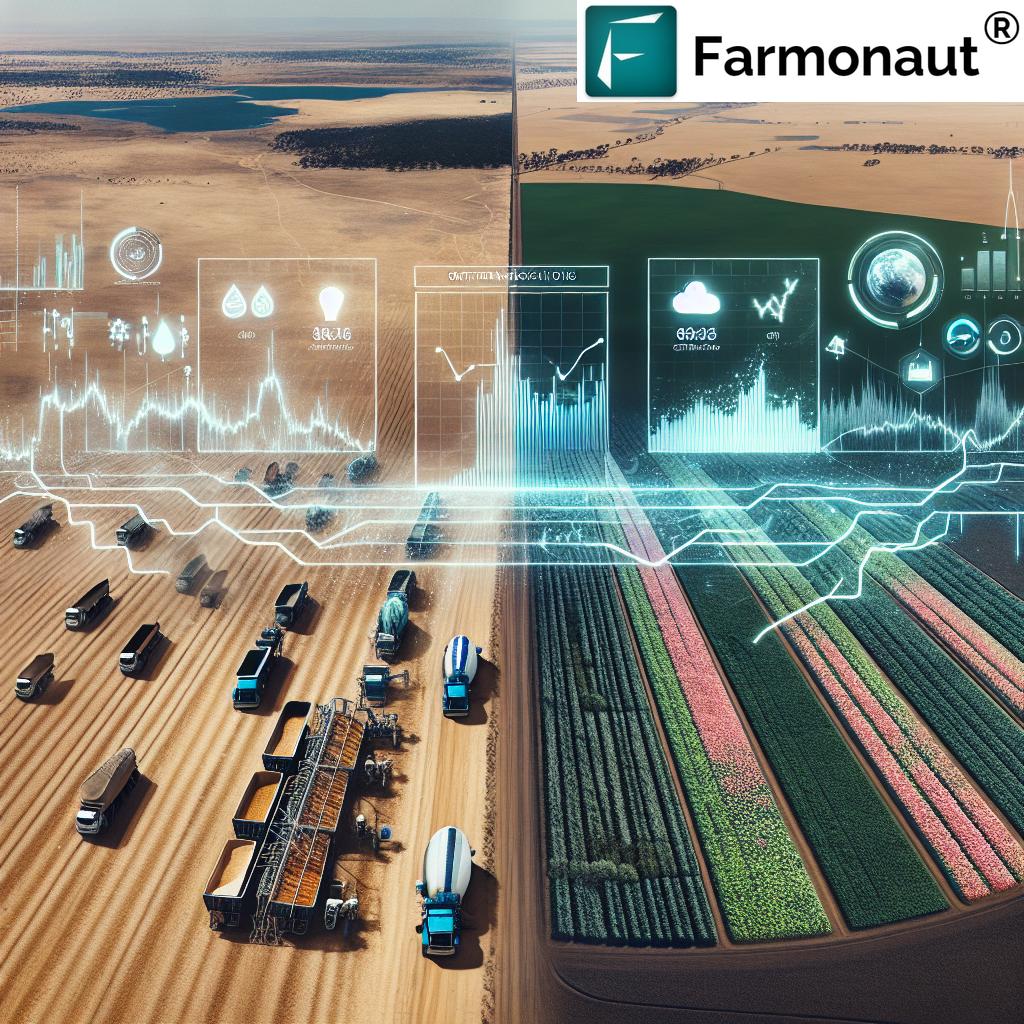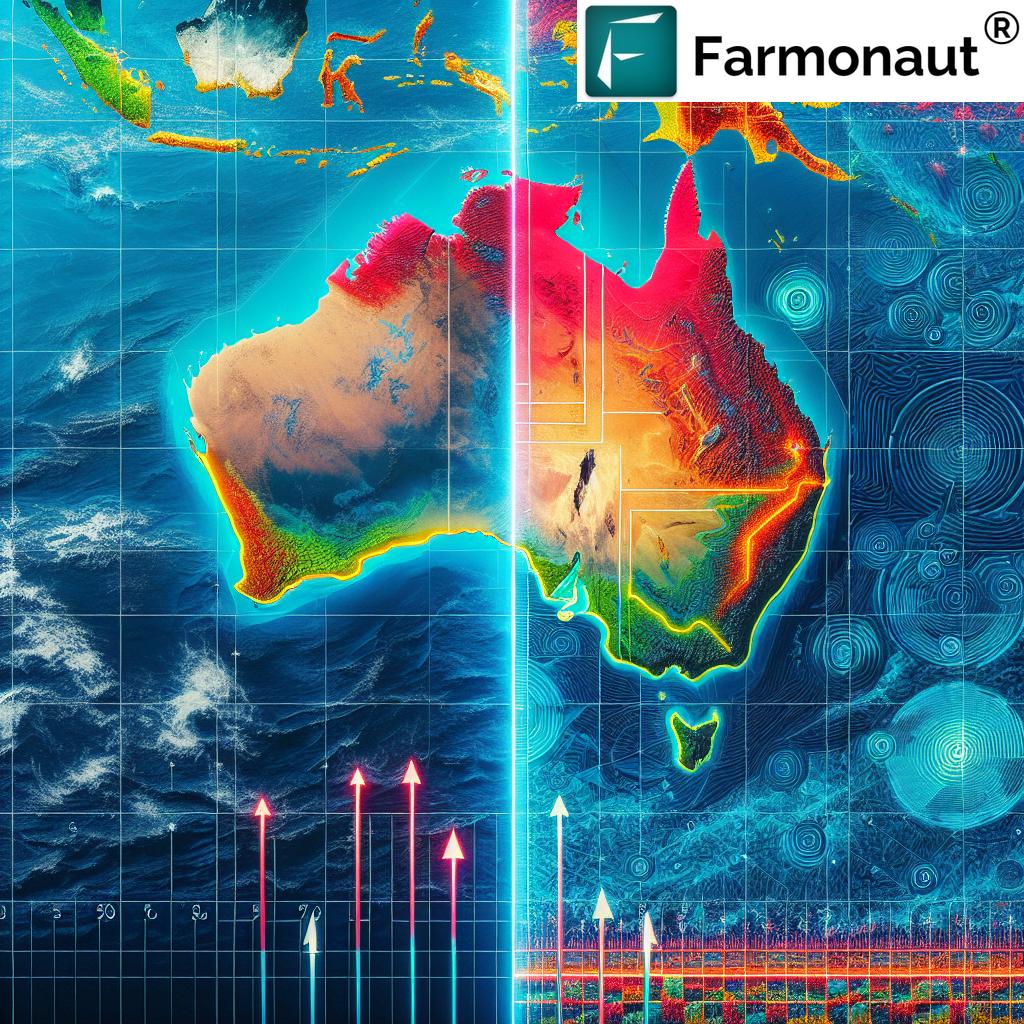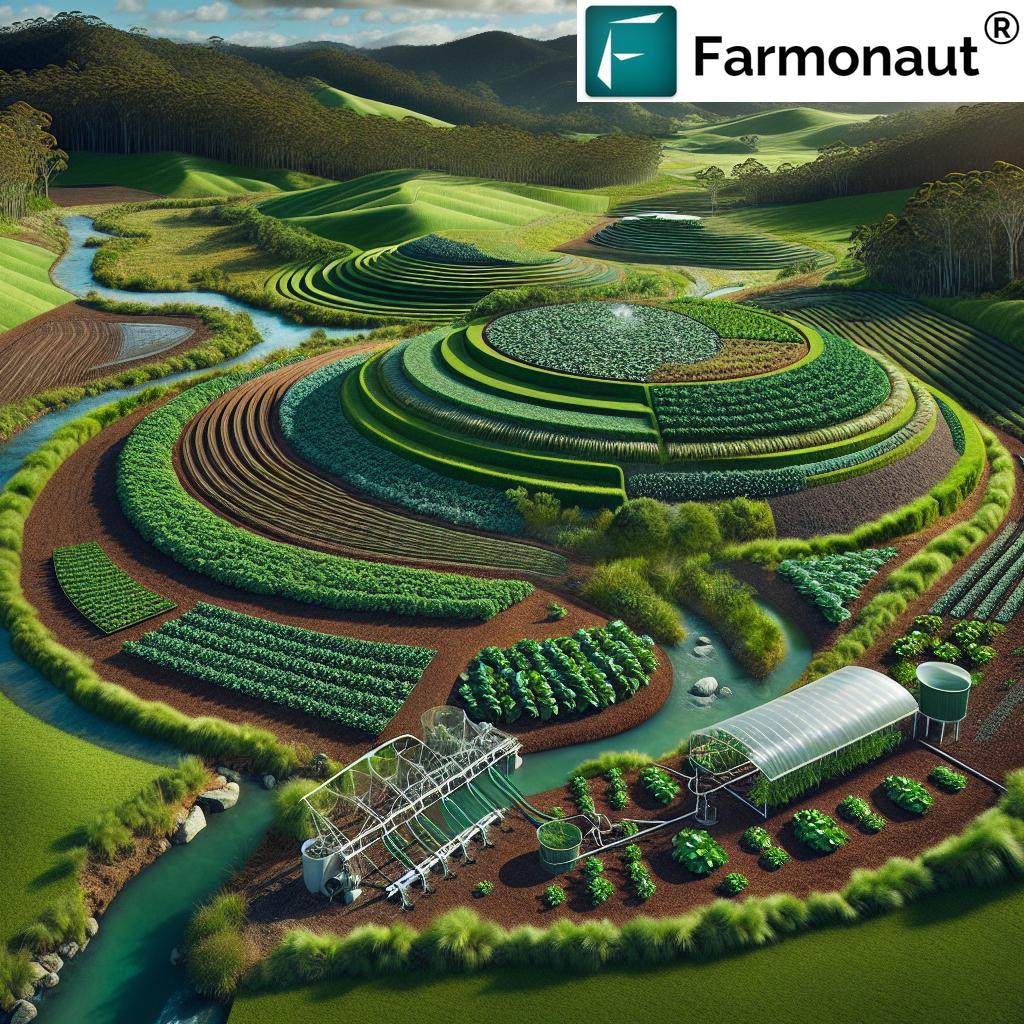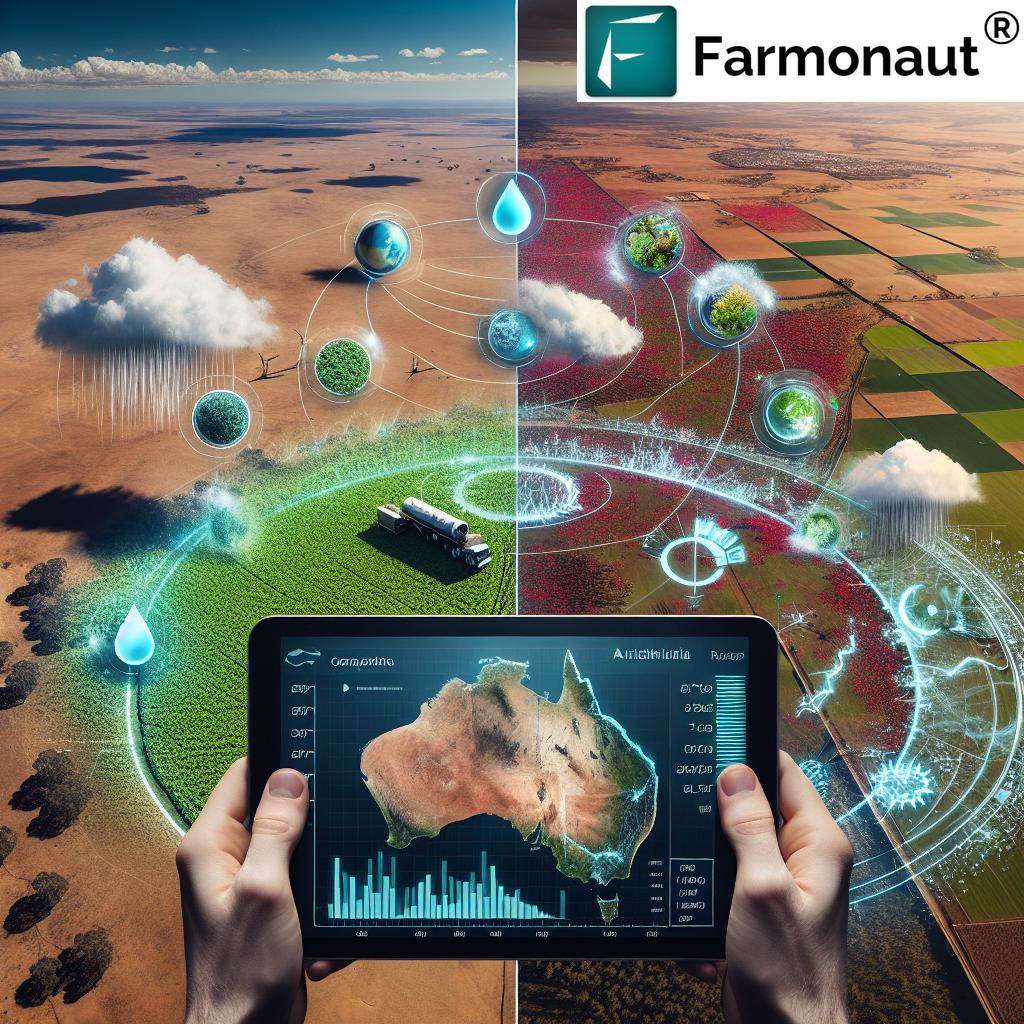Pure Manuka Honey: 7 Benefits for NZ Farming 2026
Manuka Honey in Agriculture and Apiculture: The Rising Gold of 2025
- Trivia: Economic Impact of Manuka Honey
- Origins and Characteristics of Manuka Honey
- Comparative Table: 7 Key Benefits
- 7 Benefits of Pure Manuka Honey for NZ Farming 2026
- Sustainable Agriculture and Manuka Cultivation
- Apiculture: The Economic and Environmental Beacon
- Manuka Honey: Traceability, Authenticity, and Quality
- Farmonaut and Sustainable Resource Management
- Future Innovations and Challenges for Manuka 2026+
- Frequently Asked Questions (FAQ)
- Conclusion
“Manuka honey production boosts rural NZ economies, contributing over $300 million annually by supporting sustainable agriculture.”
Origins and Characteristics of Pure Manuka Honey
Manuka honey, pure manuka honey, and raw manuka honey are derived from the nectar of the Manuka bush (Leptospermum scoparium), a native plant species that thrives across New Zealand and southeastern Australia. Its unique properties have propelled it from a traditional beekeeping product into a valuable commodity in agriculture, apiculture, and global food and health markets.
Unlike conventional honey, manuka honey owes its reputation—and premium status—to the presence of methylglyoxal (MGO), a naturally occurring compound that is responsible for its potent antibacterial activity. Quality brands like Manuka Health Manuka Honey, Manukora Manuka Honey, and Bee Power Manuka Honey have built enduring reputations by focusing on high MGO content, ensuring authenticity, and maintaining consumer trust.
Pure manuka honey and raw manuka honey are especially sought after for their unprocessed, enzyme-rich, and nutrient-dense qualities. These characteristics make them highly valued in pharmaceuticals, natural medicine, and high-end food markets globally.
As we move toward 2026, New Zealand’s diversified farming landscapes and shrublands continue to reap the benefits of manuka honey production. The distinctive flora supports pollinator activity during key periods, benefiting both environmental sustainability and commercial agriculture. The rise in global demand reinforces manuka honey’s role as “liquid gold” and an engine for sustainable rural economies.
Comparative Table: 7 Key Benefits of Pure Manuka Honey for NZ Farming (2026)
| Benefit | Estimated Value/Impact (2025) | Description/Relevance |
|---|---|---|
| 1. Enhanced Pollination | Up to 25% increase in local biodiversity | Manuka shrublands provide essential forage during critical periods, boosting bee health and enhancing pollination of surrounding crops. |
| 2. Increased Rural Income | Over $300 million NZD/year | Premium pricing and export demand for manuka honey support rural livelihoods and community development. |
| 3. Sustainable Land Use | Reclaims 70,000+ ha marginal land | Manuka cultivation transforms unproductive terrain into valuable, carbon-sequestering and revenue-generating landscapes. |
| 4. Improved Soil Health | Reduced topsoil erosion up to 15% | Dense root systems stabilize soil, aid in soil regeneration, and increase organic matter. |
| 5. Climate Resilience | Increasing resilient habitat buffer zones by 10,000+ ha | Manuka plants are resilient to climate variability, drought, and thrive on marginal land, helping buffer extreme weather impacts. |
| 6. Biodiversity Conservation | Supports survival of 40+ native pollinator species | Manuka supports diverse flora and fauna, acting as a keystone species for local ecosystems. |
| 7. Export Market Growth | Annual export value up 20% since 2022 | Manuka honey, especially raw and pure, continues to command premium prices, driving robust export growth. |
“Beekeeping for manuka honey increases local plant diversity by up to 25% in New Zealand’s managed landscapes.”
7 Benefits of Pure Manuka Honey for NZ Farming 2026
The rise of pure manuka honey in New Zealand farming is a story of environmental transformation, economic inspiration, and futureproof agricultural strategy. Here’s how:
1. Enhanced Pollination: Sustaining New Zealand’s Rural Landscapes
- Benefit: Manuka shrublands provide vital nectar flow during key periods, sustaining bee populations and increasing crop pollination.
- Impact: Studies show a 25% boost in plant species diversity around manuka farms, supporting both wild and managed pollinator activity.
- Why it matters: Pollinator health is crucial for food security, aligning with global calls for environmental sustainability and agricultural resilience.
2. Increased Farm Income and Rural Development
- Benefit: Manuka honey continues to command premium prices, especially pure manuka honey with high MGO content.
- Impact: The industry contributes over $300 million NZD per year, providing stable rural employment and supporting secondary businesses (packaging, transport, retail).
- Why it matters: This rural economic engine helps communities thrive and boosts the entire agricultural value chain.
3. Promoting Sustainable Agriculture and Land Rehabilitation
- Benefit: Manuka plants thrive on marginal and degraded soils; pure manuka honey transforms underutilized lands into productive farms.
- Impact: Over 70,000 hectares have been reclaimed in NZ alone, reversing desertification and supporting sustainable farming systems.
- Why it matters: Restoring land supports environmental sustainability and enhances ecosystem resilience.
Farmonaut’s satellite-driven monitoring offers real-time land use insights and carbon footprint tracking, helping producers assess marginal land productivity and guide sustainable manuka cultivation.
4. Improved Soil Health and Reduced Erosion
- Benefit: Manuka’s deep-rooted bushes stabilize soils, prevent erosion, and improve organic matter content.
- Impact: Manuka planting on farmland slopes reduces topsoil loss by up to 15%, a significant benefit for NZ’s hilly terrain.
- Why it matters: Healthy soils sustain productive agriculture and protect rivers from sediment runoff.
5. Building Climate Resilience: Adapting to Environmental Change
- Benefit: Manuka is naturally adapted to drought and climate variability; pure manuka honey production is less sensitive to extreme weather compared to conventional crops.
- Impact: Expanding manuka shrublands creates buffer zones for neighboring farmland, offering natural protection during climate shocks.
- Why it matters: This boosts the overall resilience of rural communities to climate change.
Producers can track environmental shifts and climate indicators with Farmonaut’s large-scale farm management platform, optimizing adaptation strategies in real time.
6. Biodiversity Conservation and Ecosystem Health
- Benefit: Manuka honey production supports a mosaic of diverse plant and animal species, acting as a biodiversity keystone.
- Impact: Over 40 species of native pollinators benefit from thriving manuka shrublands, and adjacent flora are rejuvenated thanks to consistent nectar flow.
- Why it matters: Biodiversity conservation is not only ethical, but fundamental for long-term agricultural productivity.
7. Export Market Growth and International Recognition
- Benefit: Premium raw manuka honey continues to surge in demand in the export market, with ongoing annual growth rates of up to 20% post-2022.
- Impact: Rigorous testing, high-quality control, and innovative branding from producers (such as Manuka Health Manuka Honey, Manukora Manuka Honey, Bee Power Manuka Honey) ensure NZ’s dominance in world markets.
- Why it matters: Export strength amplifies economic value for the country, securing livelihoods for tens of thousands.
Traceable supply chains—powered by new tech—are more accessible than ever with resources like blockchain-based traceability and real-time satellite monitoring.
Sustainable Agriculture and Manuka Cultivation in New Zealand
Pure manuka honey production is inseparably tied to New Zealand’s sustainable farming transition. As agriculture adapts to global climate, environmental, and economic challenges, manuka cultivation offers several major sustainability benefits:
- Resource-Efficient Plant: Manuka’s native adaptation lets it flourish on marginal lands without irrigation or intensive chemical inputs.
- Soil Regeneration: Deep roots help regenerate degraded soils and sequester carbon, supporting both local ecology and NZ’s carbon neutrality targets for 2026 and beyond.
- Pollinator Health: Continuous nectar production from manuka shrublands strengthens ecosystems for bees and other pollinators, addressing critical global concerns.
- Integrated Land Use: Mixed farming systems that blend manuka shrubs with crops and sheep grazing maintain land resilience and economic diversity.
The environmental benefits (biodiversity, soil stabilization, sustainable production) have made manuka honey central to New Zealand’s futureproof agriculture model.
Interested in forest or large-scale farm advisory for manuka cultivation? Get precision forest and plantation advisory with Farmonaut’s tools for maximizing environmental and production outcomes on your land.
Apiculture: The Economic and Environmental Beacon for Rural NZ
The apiculture sector’s growth is closely linked to the global reputation and economic value of manuka honey. Beekeeping in proximity to robust manuka shrublands produces honey with the highest MGO content and unparalleled quality and traceability.
- Rural Livelihoods: Modern beekeeping, centered around raw manuka honey and certified brands, adds jobs and injects income into remote communities.
- Direct-to-Consumer Sales: New digital platforms, such as branded producer websites, offer traceable, high-value pure manuka honey to health-conscious customers.
- Economic Stability: With premium international pricing, beekeepers gain more stable and diversified income sources than through traditional commodity honeys.
As the market grows, New Zealand continues to lead the globe in honey traceability, leveraging robust standards and transparency for superior consumer trust. Producers further benefit from Farmonaut’s blockchain-based traceability platform, ensuring every jar can be traced from hive to shelf.
Manuka Honey: Traceability, Authenticity, and Quality Assurance in 2026
Protecting the reputation of pure manuka honey is essential to prevent market dilution or fraud. In 2026, traceability and quality control are more important than ever:
- Advanced Technologies: DNA barcoding, MGO chemical profiling, and satellite-based resource monitoring are standard for verifying origin and purity.
- Blockchain-Based Traceability: Blockchain technology is now central to supply chains, providing transparent records for every jar and every batch—see Farmonaut’s solution for honey and agri-products.
- Regulations & Standards: Export controls and local standards enforce purity metrics—authentic manuka honey requires rigorous independent certification, especially for the lucrative export market.
- Consumer Confidence: High-quality brands like Manuka Health Manuka Honey, Manukora Manuka Honey, and Bee Power Manuka Honey guarantee premium products thanks in part to their investments in traceability and transparency.
For farmers, these requirements offer both a challenge and an opportunity: ensuring traceability builds long-term loyalty and justifies premium prices.
Farmonaut and Sustainable Resource Management for Manuka Producers
As demand surges for pure manuka honey and associated agricultural products, we at Farmonaut support producers, businesses, and governments with cutting-edge satellite data, AI insights, and traceability solutions. By bringing affordable, real-time environmental and resource monitoring to the palm of your hand, we empower manuka farmers and beekeepers to:
- Monitor vegetation health using AI-analyzed satellite images (NDVI, soil moisture), seeing plant stress or pest risks before they threaten honey yields or land stability.
- Track carbon sequestration with easy-to-use carbon footprinting modules, opening access to new green finance and carbon markets.
- Utilize the Jeevn AI Advisory System for precision guidance—adapting to variable weather, optimizing planting and harvesting times, and maximizing manuka shrubland health.
- Guarantee honey authenticity with blockchain-based traceability tools designed for both producers and supply chain partners.
- Streamline logistics and reduce costs using satellite-enabled fleet and resource management—optimizing beekeeping operations, truck routes, and on-farm resource allocation.
- Boost access to loans and insurance through satellite-verified crop loan & insurance verification, speeding up paperwork and enhancing security with digital oversight.
Our satellite-powered solutions are available via web, Android, iOS, and directly via API for integration in your business systems. For developer integration details, see our API developer documentation.
Future Innovations and Challenges for Manuka Honey (2026+)
Looking into 2026 and beyond, pure manuka honey remains a rapidly evolving sector in New Zealand. However, several trends and challenges warrant attention:
- Climate and seasonal change: Unpredictable flowering periods, droughts, and new pest pressures require adaptive management and next-gen monitoring—precisely the value that our Farmonaut satellite tools bring to rural producers.
- Consumer demands: Markets demand ever-increasing proof of honey quality, authenticity, and sustainability. Producers must digitize records and exceed transparency expectations.
- Technological innovation: AI-powered hive monitoring, precision beekeeping, and data-driven land management are becoming commonplace, making the sector both more competitive and more resilient.
- Regulatory compliance: Cross-border standards, especially in the EU and Asia, require New Zealand to defend and define manuka honey’s unique origins and properties.
- Economic opportunities: With strong historic export growth, the value of manuka honey to New Zealand’s rural economy will continue to rise with proper investment and sustainability strategies.
Embracing innovation in traceability, sustainability, and digital monitoring is non-negotiable for producers in the coming years. Resources like raw manuka honey and its high value will only perform if integrity and environmental stewardship remain at the sector’s core.
Frequently Asked Questions (FAQ)
-
What makes manuka honey different from conventional honey?
Manuka honey is unique because it originates from the manuka (Leptospermum scoparium) bush, native to New Zealand and parts of Australia. It contains high levels of methylglyoxal (MGO), which is responsible for its potent antibacterial activity and health benefits. It is also thick, dark, and has a distinct herbal flavor. -
How does manuka honey support sustainable agriculture?
Manuka honey production promotes sustainable agriculture by encouraging the planting of manuka bushes on marginal or degraded lands, improving soil health, reducing erosion, increasing biodiversity, and supporting pollinator health—all while generating premium-value agricultural products. -
What is the economic impact of pure manuka honey in New Zealand?
Pure manuka honey production contributes over $300 million NZD annually to rural economies via direct sales, export revenue, and the growth of related industries like logistics and packaging. -
What is the importance of MGO in manuka honey?
MGO (methylglyoxal) is a naturally occurring compound in manuka honey that provides powerful antibacterial and medicinal properties. The higher the MGO content, the higher the honey’s value and therapeutic benefit. -
How do New Zealand producers ensure authenticity and quality?
Producers use lab-based DNA analysis, chemical testing for MGO content, blockchain traceability (such as Farmonaut’s solutions), and adhere to strict NZ export regulations to ensure only genuine pure manuka honey reaches the market. -
What technologies support manuka honey production and supply chain in 2026?
Technologies include satellite-based monitoring, AI advisory systems for farm management, blockchain-based traceability for authenticity, fleet management for logistics, and real-time environmental impact tracking for sustainability. -
Where can producers and businesses access advanced tools for honey traceability and land monitoring?
They can leverage Farmonaut’s suite of web, Android, iOS, and API-based products for remote monitoring, traceability, carbon footprint tracking, and data-driven farm management.
Conclusion: Pure Manuka Honey—The Gold Standard of Sustainable NZ Agriculture
Manuka honey, pure manuka honey, and raw manuka honey stand at the crossroads of environmental stewardship, rural prosperity, and global market innovation as New Zealand moves into 2026. The synergy between advanced land use, resilient ecosystems, premium product markets, and digital traceability offers a model for sustainable, profitable, and future-proof farming. With continuous advancements in satellite monitoring, AI, and blockchain, producers can guarantee integrity from land to table—reinforcing New Zealand’s place in the world’s premium honey markets.
As climate, economic, and consumer trends accelerate, New Zealand’s pure manuka honey sector will continue to set international benchmarks—delivering on the promise of “liquid gold” not just for profit, but for a thriving planet.
Ready to future-proof your manuka honey operation? Explore Farmonaut’s advanced agricultural monitoring platform and blockchain-based traceability for honey and agri-products to take the next step.















